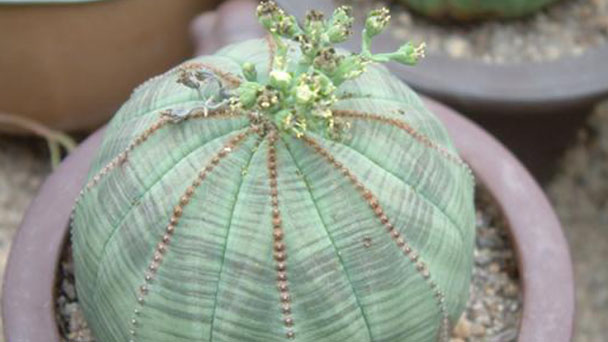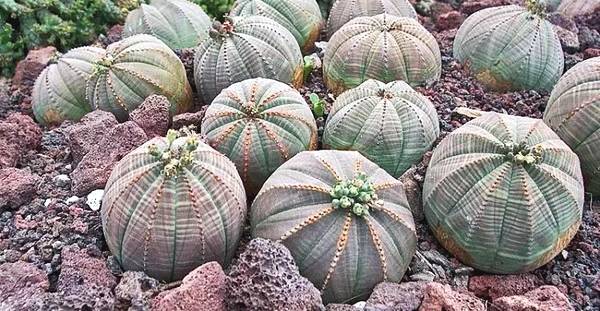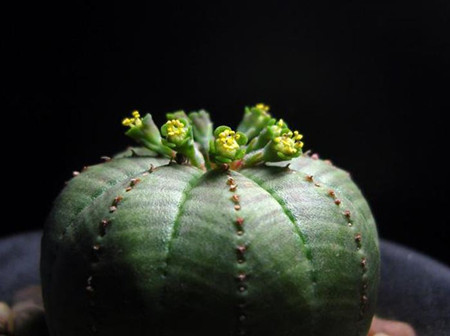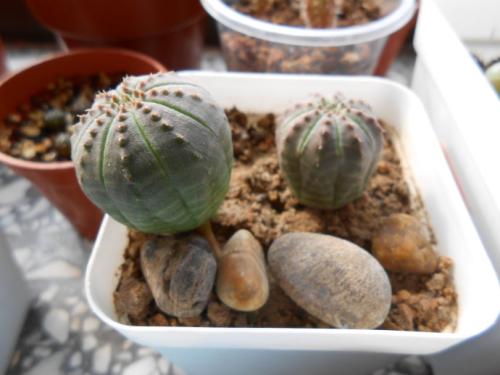Euphorbia obesa profile
Written by Maggie
Oct 13 2021

The Euphorbia obesa was originally produced in Cape Province, South Africa. Plants are small globose, 8~12 cm in diameter. There are 8 edges, neat. The stripe of crisscross of reddish brown in epidermis gray-green, top stripe is denser. Edges are with small brown obtuse teeth. Euphorbia obesa, a dioecious plant, female plant ball is flat, male plant stem cylindrical, are solitary, never from the small ball. The spherules apex is ribbed, flowers very small, yellowish green.
The Euphorbia obesa belongs to a pulpy plant. The whole body is green, the sphere is slightly oblate, the diameter is 8~12 centimeters, solitary, does not produce the small ball, the ball body is full of light color horizontal grain, looks like the cloth grain general. euphorbia obesa are rare in the Euphorbia obesa genus, one of the most standard globes is Euphorbia obesa.
Euphorbia obesa picture

The morphological feature of Euphorbia obesa
The Euphorbia obesa is a pulpy plant. Plants are small spherical, 8~12 cm in diameter, solitary, does not produce small balls, spheres grey-green, reddish brown criss cross stripes, near the top of the stripes more dense; Euphorbia obesa has 8 broad margin, with small brown obtuse teeth;It is a dioecious plants.
The coverage of Euphorbia obesa
The Euphorbia obesa, originally from Cape Province, South Africa, is now widely grown as an ornamental plant.
The growth environment of Euphorbia obesa
The Euphorbia obesa likes warm and sunny days. Excessive dampness and darkness can cause brown blotching below the stem. Culture soil requires plain sandy soil with good drainage. In winter, it is better to maintain above 5℃ and properly maintain dry basin-soil.
The growth temperature of Euphorbia obesa is 20-28℃ with much light. In summer, please avoid strong light and direct sun. It prefers fertilizer. Apply fertilizer 1-2 times in its growth period . Euphorbia obesa is drought tolerant, avoiding water. Moderate watering in spring and autumn, keep the soil slightly moist. In summer and winter, controlled watering keeps the basin soil slightly dry.

The Euphorbia obesa propagation method
Planting can be used for Euphorbia obesa reproduction, or cutting the top to reproduce.
Euphorbia obesa usually does not produce small pellets, so it cannot be used for spreading. Usually, only seeds are used for reproducing. The problem with seed reproduction is that seeds are hard to come by, because Euphorbia obesa is a monogamous animal and in homes there is usually no guarantee that both male and female spheres will bloom at the same time. As a result, its propagation quantity is not high, which makes its price high.
The seeds of Euphorbia obesa germinate in about two weeks after planting, but the seedlings grow slowly and can usually be grafted onto a cane to encourage rapid growth. Grafted plants grow three or four times faster than those grown on the ground. Of course, the technical requirements are higher. Inexperienced people should not be used, and in the operation, do not let the juice of the king whip contact with the skin so as not to cause a toxic reaction.
The main value of Euphorbia obesa
The Euphorbia obesa can be used as an ornamental plant.Among the species of Euphorbia, there are few globes. The Euphorbia obesa is one of the most standard species of globes. What's more, the clear pattern makes it more attractive. Although it has been cultivated for a long time in China, it is still very rare because of dioecious plants and the imbalance between male and female plants (males are much less), and the possibility of obtaining seeds in cultivation is very small.
The epidemic situation of Euphorbia obesa
The whimsical look of Euphorbia obesa is favored by collectors of plants, which has led to a sharp decline in its wildlife. As a result, countries in southern Africa and internationally have adopted a law to protect wildlife, Euphorbia obesa.
In addition, due to growing threats to its habitat, artificial farming is becoming more common in Euphorbia obesa. Through greenhouse and botanical garden planting, Euphorbia obesa can also be through the legal way.

Latest Updated
- Benefits of Bugleweed - 7 Science-backed Health Benefits
- Bugleweed Dangers & Side Effects - Is It Poisonous?
- How to Plant Evergreen Trees - What You Should Know
- When to Plant Evergreens - Grow Guide for Evergreen Trees
- 12 Wonderful Evergreen Shrubs for Your Garden
- 12 Popular Evergreen Plants with Pictures for Beginners
- When And How To Prune A Lilac Bush Like a Pro
- How to Grow & Care for Lilac Vine (Hardenbergia Violacea)
- Japanese Lilac Tree (Syringa Reticulata) Care & Propagation Guide
- Shumard Oak Pros and Cons - What to Know
Popular Articles
- Winter maintenance of Antirrhinum Majus
- How to Grow Terminalia Mantaly Tree
- How to Grow and Care for Crossostephium Chinense
- How to grow Antirrhinum Majus in spring
- Peristeria Elata (Dove Orchid) Profile: Info & Care Guide
- Underwatered Snake Plant (Sansevieria Trifasciata) - Signs And How To Fix
- How to Care for Brazilian Jasmine Plant (Mandevilla Sanderi)
- How to Grow & Care for Graptopetalum Purple Delight in Summer
- Rosa Chinensis (China Rose): Plant Growing & Care Tips
- How to Care for Baby Sun Rose (Aptenia Cordifolia)